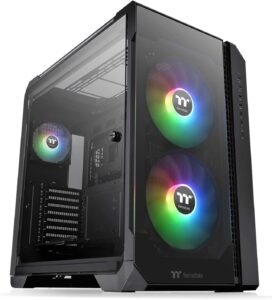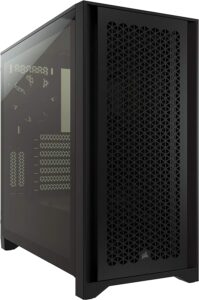Full Tower and Mid Tower are two of the most popular PC cases on the market. But how do you decide which one is best for you? Choosing between a full tower and a mid-tower can be tricky because there are so many factors to consider. In this article, we’ll break down the differences between Full and Mid-Tower cases so that you can make an informed decision. We’ll compare these two PC cases based on the following aspects:
Dimensions Motherboard Support Drive Bays PCIe Expansion Noise Levels Air And Liquid Cooling Price
Let’s dive in!
Full Tower vs. Mid Tower: A Brief Overview
Before we jump on our mid tower vs. full tower comparison, let’s talk briefly about them!
About Full Tower
A full tower is a PC chassis that is larger than standard cases. It’s designed to accommodate more components and offer more space for customization. Full Tower cases usually range from 20″ to 27″ long and 20″ to 27″ high. They can accommodate larger motherboards, such as Extended ATX (EATX) motherboards, and offer more PCIe slots for expansion. With ample internal space, a full tower can house more graphics cards and expansion slots than a mid-tower In terms of price, full tower cases are the most expensive because of their size and premium build. Generally, a full tower case can handle computer builds that perform heavy tasks, like video editing, digital audio workstations, heavy gaming (like 4K gaming), or even serve as a home server. These PC cases are popular among PC enthusiasts and gamers who need more space for customization and expansion. I’d recommend this chassis if you’re planning to expand your rig.
About Mid Tower
A Mid Tower PC case is a standard form factor that falls in the middle of the size range for desktop computer cases. It’s larger than a small form factor (SFF) or mini-tower case but smaller than a full-tower case. They have an average size of 18 inches in height, 18 inches in length, and 8 inches in width. This size is large enough to accommodate the most popular motherboard size, the ATX, as well as micro-ATX and mini-ITX motherboards. One advantage of mid-tower cases is that they offer better cable management due to their compact size. This means you won’t have long cables running inside the case, and most mid-tower cases are designed to make cable management easy and neat. Pricing-wise, mid-tower cases are cheaper than full-tower cases and don’t sacrifice performance. They can accommodate high-end video graphics cards and still have adequate storage space. They typically have two GPUs and up to six slots for storage drives, which is adequate for most users. Overall, mid-tower cases offer a good balance between size, functionality, and price, making them an ideal choice for hobby gaming players and typical office workers.
Full Tower vs. Mid Tower: A Comphresive Comparison (2023)
Now you’ve got a quick overview of the two PC cases. It’s time to compare the full and mid-tower cases to find out which is best for you. First, let’s glance at the following Full Tower vs. Mid Tower comparison table! Now let’s compare these two cases in more detail!
Dimensions
The most apparent difference between Full Tower and Mid Tower cases is their size. As mentioned earlier, Full Tower cases are larger and typically measure around 20″ to 27″ long and 20″ to 27″ high. On the other hand, Mid Tower cases are smaller and usually measure around 18 inches tall, 18 inches long, and 8 inches wide. The larger size of Full Tower cases means that they offer more space for components and customizations. However, Mid Tower cases are more compact and can fit comfortably on a desk or under a desk.
Motherboard Support
Motherboard support is another critical factor when it comes to choosing between Full Tower and Mid Tower cases. Full Tower cases support Extended ATX (EATX) motherboards, which are larger and offer more PCIe slots for expansion. Mid Tower cases, on the other hand, usually support standard ATX motherboards, microATX, and mini-ITX, which are smaller and have fewer PCIe slots. If you’re building a PC with an E-ATX board or an EE-ATX motherboard, you’ll need a full tower case. However, if you only want to fit a standard ATX or mini-ITX motherboard, you can go with a mid-tower case.
Drive Bays
If you do video editing or play games, you may quickly run out of storage space, especially if you use SSDs. Nowadays, games take up a great deal of space. For example, The Elder Scrolls V: Skyrim was under 10 GB at launch but grew to 12 GB after DLC. In addition, Grand Theft Auto 5 and Call of Duty Black Ops Cold War take up 72 GB and 175 GB of storage space, respectively. Fortunately, standard HDDs are now relatively cheap, but you still need to install them in the drive bay. If you’re a casual gamer or don’t require much storage or additional features like a Blu-ray drive, a Mid Tower PC Case will be enough. But for larger storage needs, Full Tower Cases are better. You need a Full Tower PC case for video editing, photo editing, storing RAW files from your DSLR, or dealing with huge AutoCAD drawings or 3D models. PC cases typically have SSD side mounts that free up 3.5″ drive bays. Mid Tower PC Cases have 1 to 3 SSD drive slots, whereas full towers have 2 to 6. If you choose a Mid Tower case, you can always buy external hard drives, which are plug-and-play. It’s a good idea to have a backup on an external hard drive in an emergency. USB 3.0 external hard drives are fast, reliable, and affordable at an all-time low price.
PCIe Expansion
A major advantage of Full Towers over Mid Towers is the PCIe slots. Even though an extra slot may not seem like much, it can make a big difference if you plan to install multiple GPUs. This is especially crucial if you work with 3D models or engage in professional 3D rendering because these tasks require several graphics cards to handle the workload effectively. In addition to spacing out graphics cards for better cooling, more PCIe slots help you optimize airflow within the case. You can prevent overheating and prevent damage to your expensive hardware by increasing the distance between the cards. In simple terms, if you are a professional in the 3D industry, a Full Tower case may be your best bet. This ensures that your setup runs efficiently and effectively.
Air And Liquid Cooling
To ensure optimal performance, it is important to maintain a cool temperature within your computer. But this is not always the case, as many computer components generate heat during operation. Luckily, you can easily improve the cooling system by adding extra fans to your chassis. The more air circulates through the case, the more heat dissipates, and the components operate at cooler temperatures. Effective airflow is crucial for maximizing your computer’s performance. The Full Tower PC Case is naturally larger, offering more space for additional fan mounts. But the Mid Tower Cases are just as capable of maintaining proper airflow and keeping your components cool. Size also plays a significant role in cooling efficiency. A larger case provides more space for air to pass through, ensuring optimal cooling performance. Therefore, Full Tower Cases are better at maintaining a healthy airflow because fewer obstructions could hinder air circulation. The components are also spaced further apart, which aids in maintaining a healthy temperature. Additionally, this provides ample room for the CPU cooler and GPU fans to work effectively. Larger motherboards also provide more space between the heat sinks, graphic cards, and CPU coolers, reducing disruptions in the airflow. Liquid Cooling – If you plan to incorporate liquid cooling in your PC, a larger case will make installation easier. Liquid cooling systems come in two configurations: closed-loop and open-loop. Open-loop systems require regular maintenance, which is easier to perform on a Full Tower Case. The larger size also provides more options for bigger radiators, making it easier to mount them. As a result, both Full Tower and Mid Tower Cases are excellent options for keeping your computer components cool. But if you plan to incorporate liquid cooling or want more space for fans, a Full Tower Case would be a better choice.
Noise Levels
As far as noise levels go, Full Tower PC Cases are generally quieter than Mid Tower cases. This is because they can accommodate multiple fans to maintain a cooler temperature. With a proper push-and-pull fan arrangement, your fans won’t have to work too hard, resulting in a quieter overall experience. Some Mid Tower Cases also offer noise-dampening features, making them a suitable option for those who want to game or work quietly without disturbing others. The Fractal Design Define S is an excellent example of a Mid Tower case with noise-reducing features. It can help maintain a peaceful environment even during intense gaming sessions.
Price
Price is always a consideration when it comes to building a PC. Full Tower cases are typically more expensive than Mid Tower cases due to their larger size and more extensive feature set. If you’re on a tight budget, a Mid Tower case is a great option.
Full Tower vs. Mid Tower Case: Which is Right for Your PC Build?
So which PC case is right for you? The answer depends on your specific needs, budget, and preferences. The reason for this is that both cases have their own pros and cons. Here’s a summary of which one you should choose over the other: Choose a Full Tower case if:
You need more space for customization and expansion. You plan to install heavy-duty components like EATX motherboards, multiple GPUs, or storage drives. You’re into activities that require heavy computing, such as video editing or 4K gaming. You want a premium build and don’t mind paying more.
Choose a Mid Tower case if:
You’re looking for a good balance between size, functionality, and price. You don’t need as much space for components and expansion. You’re a typical office worker or a hobby gamer. You want better cable management and a more compact size that fits on or under a desk. You want an affordable PC case.
Whichever case you choose, make sure to consider factors such as size, cooling capabilities, compatibility with components, storage capacity, cable management, accessibility and convenience, and price.
Conclusion
Hopefully, this full tower vs. mid-tower comparison helped you make an informed decision. If you’re building a powerful PC with multiple graphics and expansion cards and need ample storage and cooling, go for a Full Tower case. A Mid Tower case may be a better choice for a smaller PC with fewer components and storage options. Also, it’s a good choice if you’re on a budget. Pick one that fits your budget, storage needs, cooling requirements, and expansion plans. Further Reading:
Wall-Mounted PC Examples You Can’t Take Your Eyes Off 8 Best Budget PC Cases to Buy (Under 100 USD) What is a Motherboard IO Shield? How to Use it?

